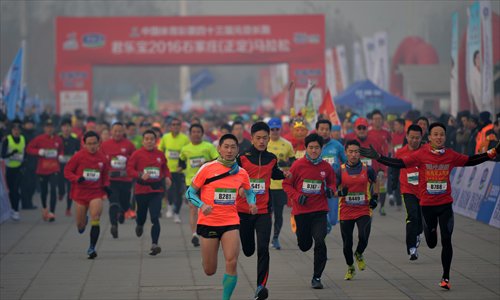HOME >> CHINA
After race deaths, authorities say better safety measures needed
By Kou Jie Source:Global Times Published: 2016-1-17 19:53:01

Amateurs run in a marathon held in Shijiazhuang, North China's Hebei Province, on January 1. Photo: CFP
The number of marathons and amateur long-distance runners in China continued to grow in 2015, but along with this growing enthusiasm for the sport has come a greater awareness of the risks such events bring.A total of 134 marathons were held in 2015, 10 times more than five years ago, attracting 1.5 million participants, the Chinese Athletic Association (CAA)reported.
However, deaths during races - five runners died in 2015 alone - have worried many Chinese amateur athletes, who are now demanding that organizers take effective steps to prevent such tragedies.
A sport in ascendancy
According to the CAA 2015 annual report, the number of marathon runners in China has surpassed 1 million for the first time, compared to 900,000 in 2014. On October 18, 11 marathons were held in China at the same time, the most ever held on a single day in the country.
"The CAA lowered the standard for holding marathons as well as waiving registration fees in 2015. Such measures have partly led to the growth of marathons in 2015," a Beijing-based marathon expert surnamed Chen told the Global Times.
Besides, the central government's investment in sports has attracted many organizations and companies to promote marathons in China.
In October 2014, the State Council announced that it would boost the sports sector in an attempt to help the industry reach a value of 5 trillion yuan ($800 billion) by the end of 2025.
"Facing such a lucrative market, many companies chose marathons as a way to gain profits, since such a massive event can attract many participants," Chen said.
Rising public awareness of health has also attracted more people to try the sport, Chen added.
Eighty percent of Chinese sports lovers have bought running shoes, while 71 percent of men and 69 percent of women said that running is their favorite exercise, according to a survey by Nielsen, a New York-based global information company.
The public today regard marathons less as a competitive sport and more as a way to stay healthy. People used to think that the ultimate goal was to get a medal, but now they realize that marathons represent an attitude and a healthy way of living, Ye Ping, a 27-year-old marathon runner, told the Global Times.
"Seven to eight times as many runners compete in US marathons as in Chinese races, the sport's booming has just begun in China," Lynne Zhang of Nielsen in China said in a report.
Lurking dangers
Despite the fact that marathons are booming in China, sudden deaths caused by the sport have shown flaws in the country's marathon management, as well as participants' poor knowledge of their own health conditions and the risks involved in running over 40 kilometers, experts said.
Five participants died during Chinese marathons in 2015, CAA's report read.
"Most victims are marathon amateurs. The lack of professional knowledge and awareness of their health conditions is one of the factors that caused such tragedies," Chen said.
"Marathons are not for everyone, participants should join the race based on their health condition," Li Yongsheng, a cardiologist, told the Global Times.
Marathon organizers should tell runners what kind of health conditions rule one out from doing such a strenuous sport, as well as offering them thorough body checks before races, Li added.
As one of the most popular long-distance annual running events in Europe, the Paris International Marathon, requires participants to present a medical certificate before running to ensure their safety.
Apart from that, some necessary medical instruments are scarce in China, which may delay treatment for marathon runners that fall sick during an event.
"Most of the deaths during marathons are caused by sudden cardiac arrests. If the patient can receive electronic therapy from an automated external defibrillator (AED) within three minutes, their chances of survival dramatically increase," Li said.
In nine years of Tokyo Marathon history, seven participants have suffered sudden cardiac arrests. Thanks to the large number of AEDs on hand, the Tokyo Marathon has kept its zero-death record, Li said.
Organizers should deploy at least 40 AEDs, but even some big cities in China do not contain so many such devices, while the cost of 40 AEDs can be more than 1 million yuan, which is more than some organizers can afford, Chen said.
"Some marathon organizers in China have little awareness of the dangers of marathons. They didn't or couldn't deploy enough AEDs for participants, posing potential threats to runners," Chen added.
Relevant governmental sectors have started to pay attention to sudden deaths caused by marathon. The CAA will make reducing the number of deaths its main priority in regard to marathons in 2016, and organizers are now required to have at least one AED for every kilometer of a race, China News reported in January.
"Precautions and awareness of health conditions should be the priority to prevent deaths, while China should establish detailed standards for holding a marathon," Li said.
Newspaper headline: Marathon mortality
Posted in: Society